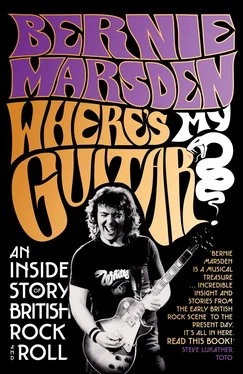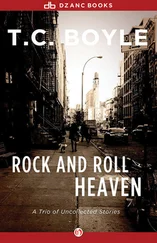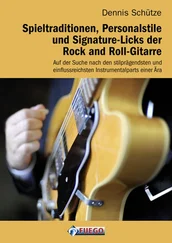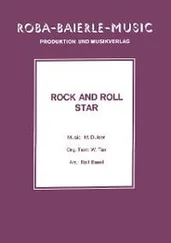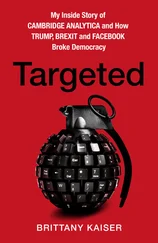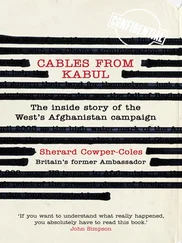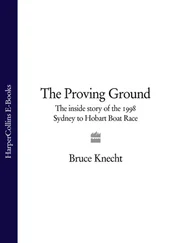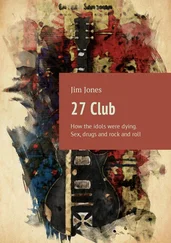In October we opened for the brilliant Irish guitarist Gary Moore with his first band Skid Row at the Haverstock Hill Country Club, near Hampstead. Skid Row were sound-checking when we walked in. Within seconds, my mouth was wide open, not only because of the utterly astonishing guitar playing of Gary, but the sheer power of the band: Brush Shiels on bass and Noel Bridgeman on drums. The frenetic style of the music and the sheer speed at which they could play really brought home the differences between the pros and semi-pros. Gary had a woollen bobble hat, drainpipe jeans, a tank top, and the trace of a beard. He played a red Les Paul with P90 pickups. He was sitting on the drum stool, playing ‘Rambling on my Mind’ on guitar, bass drum and hi-hat – a one-man band. This was the very same song I had played back in Banbury; needless to say I didn’t play it that night!
Gary and I got along very well. He admired my newly acquired Gibson SG Les Paul, the same guitar I loaned him many years later. We were almost the same age, but I could see how much I needed to improve. Gary Moore at that time would have been a real eye-opener for any guitar player. I liked him best when he played slower and bluesier things. He soon became a treasured friend, and he played at my wedding in 1980.
The venue had one poky little dressing room but Skid Row insisted we share it. I took note of their attitude. DJ Bob Harris introduced the bands that night and we are friends to this day. He is an extremely well-read person in music, and his knowledge of country is fantastic. He still remembers those brilliant days at the Country Club.
We also opened in London for performance art collective Principal Edwards Magic Theatre and prog band Van Der Graaf Generator, who were both more than snobby backstage. Slade, by contrast, had that whole skinhead thing, and really did look very intimidating. They were actually quite scary with their very loud Midland accents. They put on quite the most foul-mouthed act I had ever witnessed. I was quite disgusted, even at 19. But any negative first impressions dissolved after we chatted and found they were actually really decent blokes. Noddy Holder told me that all the effing and blinding was part of the show and the crowd loved them.
Seeing the different sides of genuine people in bands as I did with Skid Row and Slade made me think about my future. It had dawned on me that the music business was a very broad church and could accommodate both Gary Moore’s obvious genius and the basic honesty of Dave Hill’s guitar playing. It was a real eye-opener for me, as were some of the dirty tricks played by headliners to make their support acts look bad.
One of these was Stray, who had a record deal. We were pleased to be on the bill with them. We thought we would be able to use the in-house PA system, but Stray didn’t allow it. We had to bring in our little Marshall PA system, and then Stray’s road manager didn’t like the space it was taking up on the stage. It was an unpleasant feeling to be treated so shabbily, and I made a mental note to myself that if I were ever in that position, I would know how to act. We played the gig and went down fairly well, but I never forgot their antics.
As Lowell George sang with Little Feat’s ‘On Your Way Down’, you might meet again with those you misused on your way up. That was true for Stray, I’m afraid. They never really made it, and what went around did indeed come around. Just a few years after that night in London with Skinny Cat, Stray were the opening act for the chart-topping Cozy Powell’s Hammer in the splendid Blackpool Opera House. It was 1974, and I was the guitarist in Hammer.
There were problems fitting Stray’s gear on the stage because Cozy’s kit was very large, and Hammer had a lot of backline. Was this time for my revenge? No, because I didn’t want to stoop to Stray’s level, but I was quietly pleased when our drum tech got in a heated discussion with Stray drummer Richie Cole. He looked at me sheepishly. He knew who I was and he knew we had met before but couldn’t quite remember where. I asked the tech to move Cozy’s legendary red Ludwig kit so the Stray lads could get their stuff on for their gig. Those Stray boys taught me that the stage belongs to all musicians.
Skinny Cat were not going to make it either, that much was clear. We continued to gig, but for me the goal remained getting myself a pro gig and moving to the city. While I enjoyed playing in such a strong regional band, I was also on the lookout for promising auditions. There was a newspaper kiosk at the end of Charing Cross Road and Tottenham Court Road in London that had the first London issues of Melody Maker by Wednesday lunchtime. Musicians gathered to see the ‘wanted’ ads a day before the rest of the country. The ads would promise a record deal and would give a number. You rang, and rang, and rang, and then finally got through to someone on the other end of the phone who gave you a day the following week to go to a rehearsal studio somewhere in London. You’d turn up, usually not having a bloody clue what band you were auditioning for.
But I did spot a Melody Maker ad for the Bluesbreakers, still the gig of gigs for any aspiring or established pro player. I called Miller Anderson, the guitarist of the Keef Hartley band, who helped me out after Skinny Cat had opened for the band; a good guy. Miller knew Mick Taylor who, it was rumoured, was leaving the Bluesbreakers. I was confident enough to think I might audition. It sounds a little crazy with hindsight but it shows you just how confident I must have been. Miller called Mick Taylor to see if I could skip some of the audition scenario. There would have been scores of guitarists looking for this gig with John Mayall. Miller arranged for me to meet Mick in London and also asked him to put in a word for me with John Mayall himself. Thinking about it, it made total sense. Mick Taylor had only been 17 when he joined the Mayall band himself and he would understand.
Mick lived in a flat in Porchester Road, Paddington. I rang the bell feeling nervous: Mick was a huge name, alongside Eric Clapton and Peter Green, but he was a quiet, studious kind of person and made me feel at ease, although I couldn’t help but wonder to myself where his guitars were stored in the flat. We had a conversation over coffee, and he soon enough shared some devastating information. While Mayall’s management had run the ad in Melody Maker , John had decided he wouldn’t be taking on another electric guitarist. I think Mick felt a little awkward, but I was not at all put out. I was thankful for information that had, after all, come from John Mayall himself.
I headed home, admittedly feeling a little deflated. Mick was not much older, but he had so much more experience and was already a tremendous blues guitar player. Of course, he also knew at the time that he would be joining the Rolling Stones in the near future. He didn’t tell me then, but when the news was announced I was excited – I knew a Rolling Stone! The holy trinity of Clapton, Green and Taylor – was it ever better than that? What a time to be playing the guitar.
I finally got to play on stage with Mick Taylor in October 2016 at a Jack Bruce memorial gig in Shepherd’s Bush. We stayed at the same hotel and I told him about the time we first met. He didn’t remember any of it, why should he? I had been the kid from nowhere back then. At last we finally got to perform together and he played some truly beautiful stuff. It may take years but music always brings you together.
Another disappointment followed my first encounter with Mick Taylor. This time it was with Alan Clarke of the Hollies. He drank in the same Hampstead pub as my dear uncle, Ken Gotts, and said that he was putting a band together. He had left the Hollies, and Ken duly mentioned his talented nephew. There was a lot of excitement at home when Ken called my mum to say he had arranged an audition. Dad drove me to Watford and gave me the money for the train. At the hall near Belsize Park I waited in the hallway for my call, my guitar case clutched tightly, excitement and nerves building. Alan shook my hand as I introduced myself as Ken’s nephew. Then, disaster. The sight of my guitar emerging from the case was met with awkward coughing from the others.
Читать дальше
